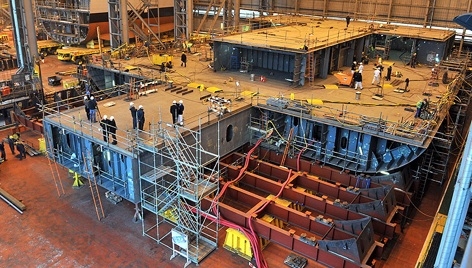As an Englishman in Scotland with the headlines still full of Fabio Capello, I should have expected it, but it started off innocuously enough. ‘Great weather for a visit,’ said John Morrison, ship manager for the Queen Elizabeth Carrier, as he met me at Govan Shipyard, Glaswegian accent as heavy as a slice of haggis. ‘It was tipping down on Sunday when we were all watching the match. All our Germany flags got soaked.’
Friendly ribbing over, Morrison and his colleague, block build manager Gerry Deighan, were keen to show off the work so far on the carrier. ‘People are often asking us “have you started yet?” or even “aren’t you going to start soon?”,’ Deighan said. ‘Well, we’ve started. Take a look.’
The main fabrication hall of the shipyard proves his point. Lower Block 3 of the Queen Elizabeth, the stern section which will contain the carrier’s engine rooms, is a massive presence: a towering chunk of welded steel, its gently curving base held about five feet off the floor on huge cradles, its upper section nearing roof level. Figures in hard hats, steel-capped shoes and hardhats swarm over it and the air is full of the glare and hiss of welding torches.

‘We’re installing ancilliary equipment just at the moment,’ Morrison said, indicating a section of walkway being hoisted onto the deck by an overhead crane. ‘And we’re shotblasting and painting sections too. As everything is completed, we cap it off, ready for the final assembly of the ship.’ Lower Block 3 is about 30 percent complete and will be sent off by barge to Rosyth, where the ship will be assembled, in around a year’s time.
In another hall, Deighan introduced me to an engineer called Andy, who was operating a robot plasma cutter to prepare sections of steel ribs that will reinforce the decks on Lower Block 4, which is starting to take shape next to Lower Block 3. The cutter operates with six degrees of freedom, performing cuts which are uploaded directly from the CAD drawings of the ship design.
‘Before we got this equipment, this was a three-man job at least,’ Andy told me. ‘One would take the paint off the area we were cutting, then another would draw on the outline of the cuts, and the third would do the cutting itself with a handheld torch. No matter how skilled they were, that would leave you with a jaggedy edge that would need a lot of grinding. This is all automatic; the plasma jet goes through like a knife through butter, and it leaves a clean edge that needs a lot less work. And it takes 20 minutes for the whole piece, instead of a good few hours.’
Morrison is particularly pleased with the safety culture on site, which he describes as a step change. ‘A lot of it is down to the way that senior management behave, and also the training that we give,’ he said. ‘But I was surprised at how quickly the operators have taken it on-board; when I saw the targets originally, I thought it would take us a couple of years longer. But our safety record is fantastic.’ Morrison also said that the progress on the project was greatly assisted by the cooperation of the trade unions at the shipyard. ‘It wouldn’t have been possible without them,’ he added.
It’s the scale of the project that’s truly staggering. Outside the main hall, stern-down on a slanting slipway, is the streamlined bulk of the Type 45 destroyer Duncan, in its final stages of construction ahead of its October launch. ‘That’s 7,500 tonnes,’ Deighan said. ‘When Block 3 leaves next year, it’ll be about 9,500 tonnes. Just Block 3.’
Govan is a busy place, but these are tough times for the industry, and the upcoming Security and Defence Review is casting a shadow. ‘Of course we’re concerned,’ Deighan said. ‘We’re going great guns here, dead on schedule, and we’re due to start work on Prince of Wales [the second carrier] next April. But the defence review does means that the project could be delayed, and we’ll have to wait and see what they say.’
A guest blog from the chief engineer of the Aircraft Carrier Alliance, David Downs, will begin on The Engineer’s website next week.










Water Sector Talent Exodus Could Cripple The Sector
Maybe if things are essential for the running of a country and we want to pay a fair price we should be running these utilities on a not for profit...